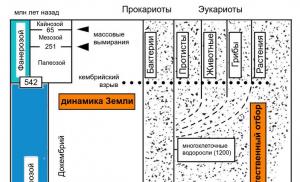Reserve capital is directed to. Nuances of formation, use and accounting of reserve capital
Score 82 accounting- this is a passive account “Reserve Capital”, reflects the creation of reserve capital and the purposes for which it is directed. Let's consider the specifics of using account 82 in accounting and examples of business transactions for the formation of a reserve fund and postings to account 82.
Reserve capital is created from the net profit of the organization.
Amount of reserve capital:
- For JSC must be at least 5% authorized capital;
Amount of contributions to the reserve:
- For JSC, at least 5% of net profit per year;
- LLCs determine the value at their own discretion.
Purposes of using reserve capital:
- Loss coverage;
- Redemption of own bonds;
- Redemption of own shares.
The size of the authorized capital of most LLCs is small and usually amounts to 10,000 rubles. The amount of reserve capital directly depends on the size of the management company and amounts to a small amount of 10,000 rubles. That's why, reserve capital For most, LLC is of a formal nature and does not solve the problem of covering the organization’s losses.
Account 82 in accounting
The credit balance of account 82 shows the amount of reserve capital available to the organization:
Two types of reserves are created on the account, which are presented in the diagram:

Formation of a reserve fund and posting to account 82
Let us give examples of business transactions for the formation of a reserve fund and postings to account 82.
Get 267 video lessons on 1C for free:
Example No. 1. Additional accrual of the reserve fund in connection with legal requirements
Let’s assume that a private security company (PSC) had a capital account balance as of December 31, 2009:
- Account balance 80 - 10,000 rubles;
- Account balance 82 - 1,000 rubles;
- Account balance 84 – 41,000,000 rubles.
The company's charter provides for the creation of a reserve fund in the amount of 10% of the amount of its authorized capital. The reserve fund has been formed in full.
In December 2009 Amendments were made to the law “On Private Security Activities”, in particular, the authorized capital of a private security company providing armed security services cannot be less than 250,000 rubles.
In January 2010 the organization brought the amount of authorized and reserve capital into compliance with the law.
Postings for the formation of the reserve fund in account 82, made in the organization in January 2010:
The private security company's balance in its authorized and reserve capital accounts as of January 31, 2010 was:
- Account balance 80 – 250,000 rubles;
- Account balance 82 - 25,000 rubles.
Example No. 2. Formation of a reserve fund
Let’s assume that the authorized capital of an LLC engaged in the sale of alcoholic beverages is 1,000,000 rubles. The charter of the LLC provides for the creation of a reserve fund in the amount of 15% of the amount of its authorized capital. The reserve fund is formed by deductions from profits until the fund reaches the specified size. The amount of annual contributions to the reserve fund is 5% of net profit. The organization was registered in the Unified State Register of Legal Entities in 2008.
Table of indicators and calculation of reserve capital:
| Years | Profit (+)
Loss (-) |
The amount of reserve capital provided for by the charter | Reserve,
subject additional accrual |
Credit balance on account 82 at the end of the year | |
| 2008 | -200000 | none | 1000000*5%=150000 | none | |
| 2009 | -320000 | none | none | ||
| 2010 | +200000 | 10000 (200000*5%) | 150000-10000=140000 | 10000 | |
| 2011 | +400000 | 20000 (400000*5%) | 140000-20000=120000 | 30000 | |
| 2012 | +3250000 | 120000 (150000-10000-20000)
(3250000*5%)=162500 162500>150000. 150000 is involved in the calculation |
120000-120000=0 | 150000 |
Postings to account 82 made in the organization:
| Dt | CT | Sum
(rub.) |
Contents of a business transaction | Document |
| In December 2010 | ||||
| 84 | 82 | 10000 | Contributions to reserve capital | |
| In December 2011 | ||||
| 84 | 82 | 20000 | Contributions to reserve capital | Charter, accounting certificate |
| In December 2012 | ||||
| 84 | 82 | 120000 | Contributions to reserve capital | Charter, accounting certificate |
The reserve capital (some call it the fund) is property of the enterprise, the source of which is deductions from retained earnings. For organizations established in the form of joint stock companies, the obligation to create such funds is established by law.
Its functions
Many modern economists and accountants consider reserve capital in a simplified form. They believe that the only function it performs is protective. At the same time, there is an opinion that it is needed only to cover financial losses incurred in the process of activity. This is fundamentally wrong. We can highlight several more important functions that are performed by the funds created in the form of a reserve.
Legislative requirements for the formation of such funds allow the state to influence the activities of various types of organizations.
 Today in Russia this is the way to influence enterprises created in the form of joint stock companies and companies with foreign participation.
Today in Russia this is the way to influence enterprises created in the form of joint stock companies and companies with foreign participation.
In the process of creating capital, management personnel are encouraged to adequately assess its size. Due to the fact that this money is diverted from circulation, there should not be too much of it. The adequate size of the fund should be calculated based on the riskiness of the activity, as well as the growth of the scale of the business.
For what purposes is it created?
The directions for spending these funds are determined primarily by the legal form of the organization.
For joint stock companies, the purposes of creating reserves, as well as their other parameters, are strictly regulated by law. In this case, funds can be spent on:
- covering losses incurred in the course of business;
- in the absence of other sources for repaying bonds and organizing the repurchase of shares.
 Regardless of their size, the funds created by the joint-stock company cannot be used to solve any other problems.
Regardless of their size, the funds created by the joint-stock company cannot be used to solve any other problems.
For other forms of business organization, there are no legislative restrictions on the areas of spending such funds. These goals are usually set out in the company's founding documents.
Dimensions
The main source of formation of this capital is the company's retained earnings. It is understood as that part of the profit that was not spent in previous periods. Most often it is used for business development.
Joint stock companies
In relation to JSC, Russian legislation establishes not only the obligation to make contributions cash to funds. Their minimum size.
Today, the amount of formed reserves should not be less than 5% of the authorized capital.
The specific value is fixed in the constituent documents. If a new organization is created in accordance with the law, it can form a fund not at once, but gradually. Then, until the established amount of reserves is reached, the company’s responsibility is to annually set aside at least 5% of the net profit received.
Limited Liability Companies
 LLCs have no obligations to create reserve funds in Russia. Nevertheless, companies created in this form have the right to do so.
LLCs have no obligations to create reserve funds in Russia. Nevertheless, companies created in this form have the right to do so.
The organization's charter may have a clause on reserve capital. The procedure for its creation and the amount of required contributions are fixed here. Every year, after the formation and consideration of financial statements, the owners of the LLC at a meeting decide on how to distribute profits. They can use it for these purposes as well.
Companies with foreign participation
According to Russian legislation, companies created with the attraction of foreign investment are required to form such a fund. Its minimum size is determined at the level 1/4 of the authorized capital.
Accounting Features
The current regulation regulates the accounting of this capital on the passive account of the same name 82. Sub-accounts called reserve fund available and used can be opened on it. In accordance with the features of maintaining passive accounts an increase is taken into account for its credit, and a decrease in the amount of the reserve is taken into account for its debit.
Joint-stock companies can account for the following funds in this account:
- spare;
- created to corporatize employees;
- intended for payment of dividends on preferred shares;
- others created on the basis of the charter.
Other organizations account for reserve funds in this account, as well as others formed in accordance with the charter.
Accounting entries
All transactions made using account 82 can be divided into groups depending on in which direction and in connection with what the size of the fund changes:
- formation;
- spending;
- decrease.
Formation
As noted earlier, the reserve is formed from retained earnings. Therefore, such a situation is reflected in accounting as follows:
- Debit of account 84 “Retained profit/uncovered loss” - Credit of account 82 “Reserve capital”.
If the founders decide to create reserves to increase the company’s capital by contributing property or non-property rights belonging to them, the following entry is made in the accounting:
- Debit of account 75, used to account for settlements with owners - Credit 82.
Usage
If a decision is made to use reserve funds to cover losses incurred, an entry is made with account 84, which is the reverse of what was done when they were formed:
- Debit 82 - Credit 84 in terms of reflecting uncovered losses.
 It is important to understand that in accounting, covering losses by spending created reserves is considered an event that occurred after reporting date. This means that in the period for which reporting is provided, the relevant information is reflected in the explanatory note and the report reflecting profits and losses.
It is important to understand that in accounting, covering losses by spending created reserves is considered an event that occurred after reporting date. This means that in the period for which reporting is provided, the relevant information is reflected in the explanatory note and the report reflecting profits and losses.
The corresponding entries will be generated in the next reporting year.
If such a situation arises in a joint stock company, it must subsequently make contributions to reserves until the required amount is restored.
In cases where bonds are repaid using reserve funds, in correspondence with account 82, accounts 66 or 67 are used, depending on the period for which they were issued:
- Debit 82 - Credit to account 66, intended for accounting for settlements on short-term obligations.
- Debit 82 - Credit to account 67, intended for accounting for settlements of long-term liabilities.
When the reserve is allocated for the repurchase of shares, the following block of records is formed:
- The situation of repurchase of securities is reflected in the Debit of account 81 “Own shares (shares)” and the Credit of cash accounts depending on the funds used.
- Cancellation of the corresponding shares – Debit 80 “Authorized capital”, Credit 81 for the amount of their par value.
- Attribution of the difference between the nominal value and the actual amount paid at the expense of reserves – Debit 82, Credit 81.

Decrease
In the event of a decrease in the authorized capital of an organization, it has the right to reduce the size of the reserve fund in order to bring it into compliance with the constituent documents.
In this case, after the state registration of the relevant changes is carried out, the following entries are made in accounting:
- Debit account 82 – Credit account 84.
In conclusion, I would like to note that the creation of reserves is important for any organization. At the same time, the operation of their expenditure is not capable of changing the size of net assets. In fact, it only reflects the change in the shares of various sources that form equity companies.
If the law regulating the activities of an organization does not mention the possibility of creating a reserve fund, either mandatory or voluntary, this does not deprive the organization of the right to establish a corresponding provision in its constituent documents.
The sources of formation of the reserve fund can be:
- deductions from the organization’s net profit;
- contributions of members (shareholders), etc.
Replenish the reserve fund until the fund is fully formed (i.e., in the amount established in the organization’s constituent documents). After this, contributions (contributions, contributions, etc.) to the reserve fund may temporarily not be made.
When the reserve fund is spent, its size becomes less than the established value. In this case, resume replenishing the reserve fund until its size meets the requirements of the law and (or) constituent documents.
Organizations that are required to create a reserve fund can use it only for strictly defined purposes. Organizations that create a fund voluntarily, as a rule, can use it for any purpose specified in the constituent documents (charter).
Situation: is it possible to change the size of the reserve fund originally fixed in the organization’s charter?
Answer: yes, you can.
The procedure for the formation (including the size) of the reserve fund is approved by the competent body of the organization and is enshrined in its constituent documents (charter) (see, for example, paragraph 1 of Article 35 and paragraph 3 of Article 11 of the Law of December 26, 1995 No. 208-FZ, paragraph 1, article 30 and paragraph 2, article 12 of the Law of February 8, 1998 No. 14-FZ).
For example, in a joint stock company such powers are vested in the general meeting of shareholders. In an LLC - a general meeting of participants.
Therefore, in order to change the size of the reserve fund, initially fixed in the charter, such a competent body must decide to increase (decrease) it and, on the basis of this decision, make appropriate changes to the constituent documents (see, for example, paragraph 1 of Article 12 and sub. 1 paragraph 1 article 48 of the Law of December 26, 1995 No. 208-FZ, paragraph 4 of article 12, subparagraph 2 of article 33 of the Law of February 8, 1998 No. 14-FZ).
However, it must be taken into account that in organizations that compulsorily form a fund, as a rule, the minimum size of the reserve fund is legally established. For example, in joint-stock companies, the reserve fund cannot be less than 5 percent of the authorized capital (clause 1, article 35 of the Law of December 26, 1995 No. 208-FZ).
In accounting, reflect the formation of the reserve fund in the credit of account 82 “Reserve capital”. The corresponding account, as well as the documents on the basis of which the accounting entry is made, depend on the source of the fund’s formation.
In the financial statements, reflect information about the reserve fund:
- V Balance sheet. For more information, see table;
- in the Statement of Changes in Equity. For more information, see table.
This follows from paragraphs 5, 20, 30 of PBU 4/99.
Formation of a reserve fund from net profit
If the reserve fund is formed from the net profit of the organization (for example, such a source of fund formation is mandatory for joint-stock companies), then its creation (replenishment) should be reflected in accounting by posting:
Debit 84 Credit 82
- deductions were made to the reserve fund from retained earnings.
This follows from the Instructions for the chart of accounts (accounts 82, 84).
Do the wiring on the basis accounting certificate, in which provide the calculation of contributions to the reserve fund (Part 2 of Article 9 of the Law of December 6, 2011 No. 402-FZ).
An additional decision of the general meeting of participants (shareholders) of the organization on the direction of net profit to the reserve fund is not required. Since if an organization creates it (by force of law or voluntarily), then the obligation and procedure for forming the fund are fixed in the constituent documents (charter) of the organization. Therefore, owners are not required to regularly confirm a previously made decision. This conclusion follows, for example, from paragraph 1 of Article 35 of the Law of December 26, 1995 No. 208-FZ (for joint-stock companies), paragraph 1 of Article 30 of the Law of February 8, 1998 No. 14-FZ (for LLCs).
Since an additional decision of the general meeting of participants (shareholders) on the transfer of net profit to the reserve fund is not required, make accounting entries in the year in which the profit was received.
An example of how annual contributions to the reserve fund from the organization’s net profit are reflected in the accounting records of a joint stock company
The authorized capital of CJSC Alpha is 100,000 rubles. In accordance with the company's charter, the reserve fund must be 10 percent of the authorized capital, that is, 10,000 rubles. (RUB 100,000 × 10%). Annual contributions to the formation of a reserve fund are 6 percent of net profit. As of January 1, the size of the reserve fund is 8,000 rubles.
This year, Alpha's net profit amounted to 50,000 rubles. Thus, the amount of annual contributions to the reserve fund this year should be 3,000 rubles. (RUB 50,000 × 6%). However, since only 2000 rubles are missing before reaching the value of the reserve fund provided for by the company's charter. (10,000 rubles - 8,000 rubles), contributions to the reserve fund will amount to exactly this amount (2,000 rubles).
The accountant reflected the calculation of contributions to the reserve fund in the accounting certificate.
In December, the accountant made an entry in Alpha’s accounting:
Debit 84 Credit 82
- 2000 rub. - contributions have been made to the reserve fund in the amount necessary to complete its formation.
Regardless of the chosen taxation system, the formation of a reserve fund from the organization’s net profit does not affect the calculation of taxes. Since this does not generate expenses that can be taken into account for taxation (see, for example, Article 252 of the Tax Code of the Russian Federation, determination of the Supreme Arbitration Court of the Russian Federation dated August 12, 2008 No. 9690/08, resolution of the Federal Antimonopoly Service of the West Siberian District dated April 7, 2008 No. F04-2259/2008(3199-A27-15)).
Formation of a reserve fund through contributions
Most non-profit organizations (including credit, agricultural, consumer and housing savings cooperatives) are required to create a reserve fund, including through contributions from their members (shareholders) (clause 16, part 3, article 1, clause 1 h 4 Article 6 of the Law of July 18, 2009 No. 190-FZ, paragraph 6-7 of Article 34 of the Law of December 8, 1995 No. 193-FZ, Part 1 of Article 53 of the Law of December 30, 2004 No. 215-FZ).
Contributions received from members (shareholders) are initially recognized as targeted and accounted for in the credit of account 86 “Targeted financing”. To control the debt of members (shareholders), you can use account 76 “Settlements with various debtors and creditors.” Make the following entries in your accounting:
Debit 76 Credit 86
- reflects the debt of members (shareholders) to make contributions to the reserve fund;
Debit 55 (50, 51) Credit 76
- contributions from members (shareholders) to the reserve fund have been received;
Debit 86 Credit 82
- contributions of members (shareholders) were sent to the reserve fund.
This follows from the Instructions for the chart of accounts (accounts 82 and 86).
Make entries on the basis of documents confirming the debt of members (shareholders) for contributions to the reserve fund, and documents confirming the transfer of these contributions (Part 2 of Article 9 of the Law of December 6, 2011 No. 402-FZ).
If an organization uses common system taxation (simplified), then do not include received membership (share) contributions in taxable income. Such amounts are recognized as targeted revenues for the maintenance of non-profit organizations and the conduct of their statutory activities and are not taken into account when calculating income tax (single tax). This follows from subparagraph 1 of paragraph 2 of Article 251 and subparagraph 1 of paragraph 1.1 of Article 346.15 of the Tax Code of the Russian Federation.
The requirement of prudence in accounting implies a greater willingness to recognize expenses and liabilities than income and assets (clause 6 of PBU 1/2008). And the creation of reserves in accounting is due precisely to this requirement.
We will tell you what reserves are created in accounting in our consultation.
What reserves are there?
Reserves created in accounting can be divided into 3 groups:
- reserve capital;
- valuation reserves;
- reserves for estimated liabilities.
All these reserves differ both in the source of formation and the order of reflection in accounting.
Reserve capital
The reserve fund (capital) is formed by organizations from profits in accordance with their constituent documents and is used to cover losses, as well as for other purposes (clause 1, article 30 of the Federal Law of 02/08/1998 No. 14-FZ, clause 1, article 35 Federal Law of December 26, 1995 No. 208-FZ).
Reserve capital is accounted for on account 82 “Reserve capital” (). If profit is transferred to the reserve fund, the posting is generated by the debit of the profit account (account 84 “Retained earnings (uncovered loss)”) and the credit of account 82.
Here are the main accounting entries on the creation and use of reserve capital.
Valuation reserves
There are the following types of valuation reserves:
- reserve for doubtful debts (clause 70 of Order of the Ministry of Finance dated July 29, 1998 No. 34n);
- reserve for impairment material assets(clause 25 PBU 5/01);
- reserve for impairment of financial investments (clause 38 of PBU 19/02).
Let us reflect the accrual of valuation reserves in accounting and their use (clarification) (Order of the Ministry of Finance dated October 31, 2000 No. 94n).
Provision for doubtful debts
Reserve for reduction in the value of material assets
Provision for impairment of financial investments
Provisions for estimated liabilities
Reserves for estimated liabilities include a reserve for vacation pay, a reserve for warranty repairs and other similar reserves (PBU 8/2010).
Reserves for estimated liabilities are reflected in the account for reserves for future expenses.
We will show the accounting records that are compiled when creating and using a reserve for upcoming vacation pay.
The enterprise's own funds include reserve, authorized, and additional capital. These are the main elements through which the company’s production activities are financed. Let us consider further in detail what the organization’s reserve capital is.
General information
To compensate for losses when carrying out financial and economic activities, companies provide a reserve fund. Capital is used for payments accounts payable and payments to investors in the event of a lack of profit for the reporting year. The presence of these funds acts as a kind of guarantee of the company’s stable activities.
Legal aspect
The obligation to create reserve capital is provided for in Federal Law No. 208. This requirement applies to joint stock companies and joint corporations. LLCs, cooperatives and other commercial structures can create such a reserve of funds if this is provided for in the constituent documentation. The reserve capital of a joint stock company can be used to cover losses, repay bonds, and repurchase securities in the absence of other assets. These funds may not be used for other purposes.
Order of education
The amount of the reserve is determined in the constituent documents of the enterprise. Authorized and reserve capital are two interrelated categories. Depending on the size of the first, the size of the second is determined. Thus, in accordance with the law, the reserve capital of a joint-stock company cannot be less than 15% of the authorized capital. For companies with foreign investment this figure increases to 25%. The formation of reserve capital within the limits of the above restrictions is carried out by reducing taxable income. In this case, the amount of deductions should not be more than half of this profit. The Federal Law regulating the activities of joint stock companies provides for a requirement in accordance with which a reserve is formed. Its size must be at least 5% of the authorized capital. The upper limit may be greater than the specified indicator, since this limitation is not provided for in regulations. Reserve capital in a joint-stock company is formed through annual mandatory contributions until it reaches the value specified in the constituent documents.

Important point
Today, many joint-stock companies have reserve capital of less than 2-4% of the authorized capital. At the same time, there are no violations of legal requirements or provisions of the constituent documentation. The thing is that these companies within recent years revised the size of their authorized capital and increased it through additional ones. In some cases, the figures increased 10 times, and in others - more than a hundred times due to the increase in the value of overvalued property. In this regard, the already increased amount of authorized funds must be taken as the basis for calculating the 15% indicator. Financial reserves for other enterprises are created according to a different procedure. The main source from which funds come into reserve capital is retained earnings remaining at the disposal of the enterprise.
Reporting: general rules
Accounting for additional and reserve capital is carried out in accordance with the established rules for maintaining relevant documentation. The size of the reserve is taken into account when making decisions and carrying out business transactions in the joint-stock company. The use of these funds is within the competence of the supervisory board/board of directors. This provision is provided for in Art. 65 of the specified Federal Law No. 208. The amount of the fund is taken into account when:
- Making a decision to declare/pay dividends.
- Increasing the authorized capital.
- Payment of dividends.
- Acquisition of placed securities, including certain preferred ones.

Reserve capital: postings
The stock formation is shown as follows:
- db sch. "Losses and profits" (99), CD account. "Uncovered loss (retained earnings)" (84) - reflects the amount received net income reporting period with closing entries for December.
- Account 84 (debit), account. 82 (credit) “Reserve capital” - deductions to the reserve from net profit have been made.
The allocated amounts do not reduce taxable profit and are not included in tax expenses. In some cases, it becomes necessary to change the reserve capital. The account will reflect transactions made only if these adjustments are made to the constituent documents and registered according to established rules. In reporting, such transactions are shown as follows: Db sch. 82, Kd sch. 84 - the reserve was reduced to the value provided for in the constituent documentation.

Line 430 of the balance sheet reflects the amount of the reserve capital balance at the end of the reporting period. It can be shown both in general and in the following types:
- Created in accordance with the law.
- Formed according to the constituent documentation.
Features of the direction of funds
Accounting for reserve capital aimed at covering the company's losses, repaying bonds and repurchasing securities is carried out and reflected in the balance sheet separately. According to methodological recommendations, containing provisions on the procedure for compiling reporting indicators when considering performance results for the period and resolving issues regarding sources of financing costs, reserve funds can be used for these purposes. In accordance with clause 4, art. 88 Federal Law No. 208, the company’s annual reporting must be pre-approved by the board of directors by the supervisory body or the person solely performing the functions of the executive body. This must be done no later than 30 days before the date of the annual general meeting of participants. The decision to allocate funds constituting reserve capital to pay off losses is made after approval of the statements. Such use of finances qualifies as an event occurring after the end of the period. 
Redemption of bonds
In accordance with Art. 816 of the Civil Code, in cases provided for by law and other regulations, it is permitted to conclude a loan agreement through the issue and sale of securities. Long-term and short-term fundraising in this way is taken into account in the account. 66 and count. 67 separate from non-bond backed finance. If the placement of securities is carried out at a cost exceeding their nominal price, then entries are made according to DB account. 51 and others in correspondence with accounts 67, 66 (at nominal value) and 98 (for difference). The amount that is credited to the account. 98, is written off evenly over the period of circulation of the bonds to the account. 91, subaccount. 91-1, subaccount. 91-2. Debt on loans and credits is reflected taking into account interest payable at the end of the period. The latter act as operating expenses of the company. They are taken into account on the account. 91. Redemption of bonds is a payment on time of the nominal value and a fixed percentage of it or a property equivalent to the holder. 
Redemption of securities
According to Art. 101 of the Civil Code, a joint-stock company can reduce its authorized capital by purchasing part of the shares to reduce their total number. This is permitted if this possibility is provided for in the constituent documentation. The acquisition procedure, as well as restrictions on the purchase of placed securities, are established in Federal Law No. 208, Art. 72, 73. Changes regarding the reduction of the authorized capital are made to the constituent documentation under clause 1, art. 12 of the said law on the basis of a decision adopted at the general meeting of participants. Own securities purchased from the founders are reflected on the DB account. 81. In this case, the amount of actual expenses related to the redemption is indicated in correspondence with the CD accounts for accounting for financial assets. Cancellation of securities is reflected in the Cd account. 81 and db sch. 80 after the company has completed all procedures provided for in such cases. The difference between the actual redemption costs and the nominal value of the securities arising on the account. 81, transferred to account. 91 "Other costs and income." The postings will be as follows:
- db sch. 81, Kd sch. 50 - repurchase of own shares.
- db sch. 80, CD count. 81 - reduction of the authorized capital through the redemption of purchased securities.
- db sch. 91-2, Kd sch. 81 - reflection of the difference between the redemption cost and the nominal price of the canceled shares.

Procedure for LLC
Such companies cannot make decisions on the distribution of profits between participants:
- If the amount of net assets is less than the authorized and reserve funds or decreases after such a decision is made.
- Before payment of the actual value of the share (part thereof) of the founder.
- Until the authorized capital is paid in full.
- If there are signs of insolvency (or if they appear after the decision is made).
The law does not oblige LLCs to create reserve capital. But they can form it if this is provided for in the constituent documentation. Since this procedure for an LLC is not regulated by law, there are no restrictions on the size or procedure for creating a financial reserve. According to the law, the amount by which the authorized capital is increased at the expense of the company’s property should not be higher than the difference between the value of the net asset and the size of the reserve and authorized funds.













